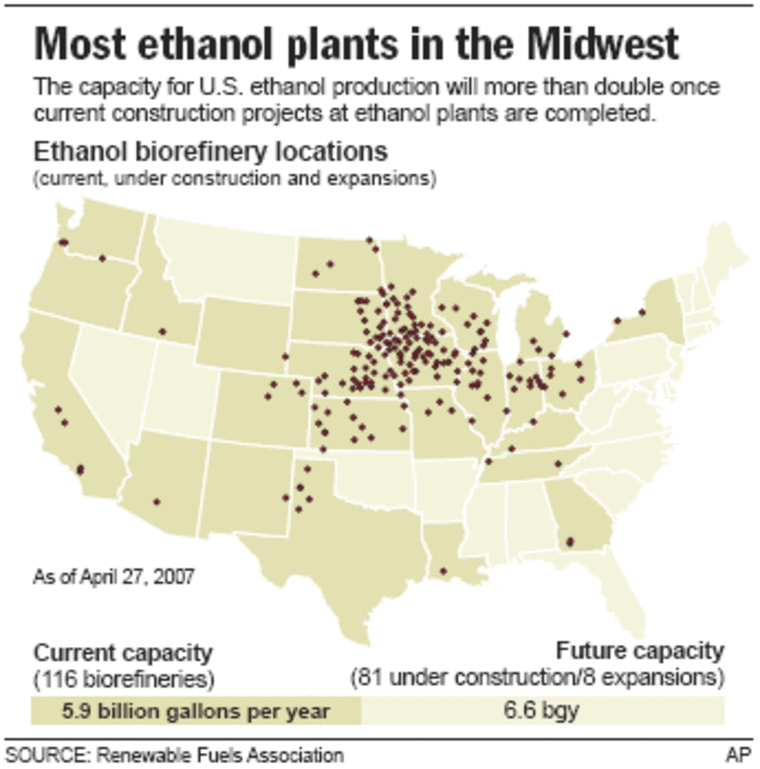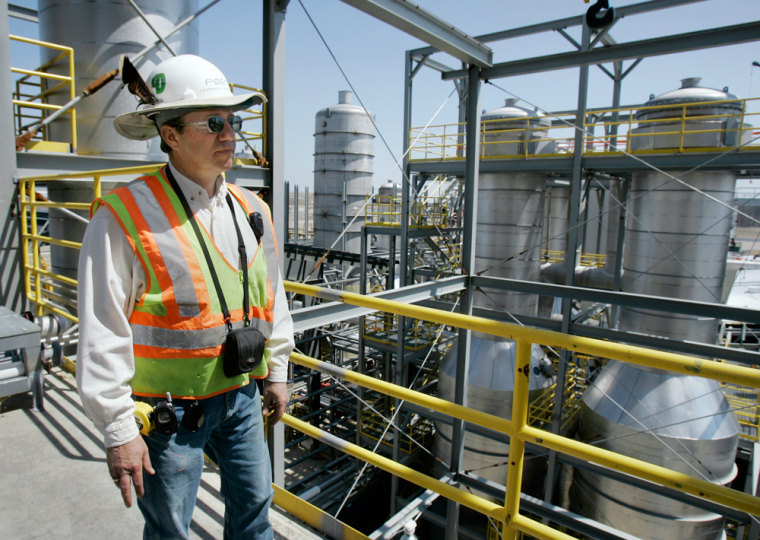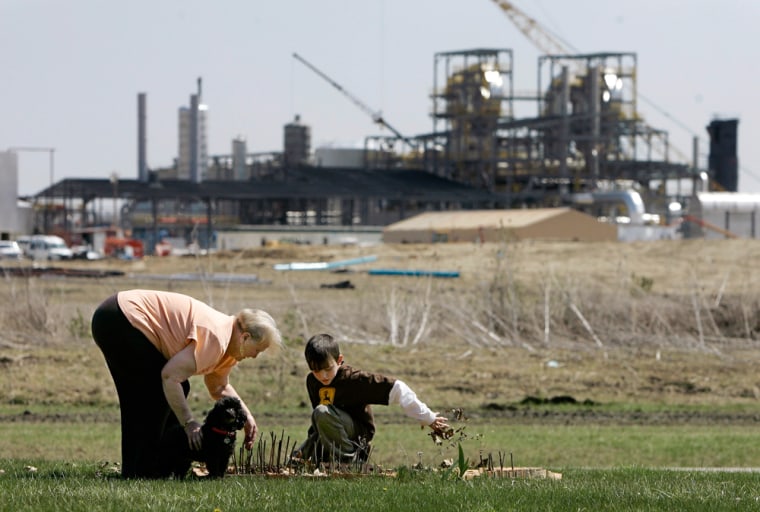The ethanol refineries sprouting across the Corn Belt are typically touted as desperately needed economic engines for rural towns, a boon for American farmers and a way to ease the heavy dependence on foreign oil.
When James Clear hears the word ethanol, he instead thinks about the tons of pollutants that will come from the 50-acre industrial complex being built on the edge of this eastern Indiana town.
“It would just kill me looking out on our playground there and picturing our kids breathing that air,” said Clear, a chiropractor who sold the house on family land after learning a South Dakota company planned to build an ethanol plant a half-mile away.
Ethanol has long been touted as a cleaner-burning alternative to gasoline and it carries the image of an environmentally friendly fuel since it’s derived from plants and plant waste. Experts say replacing gas with ethanol blends will reduce greenhouse gases and help the fight against global warming.
But the more than 200 U.S. refineries in operation or under construction — mostly in a swath from Nebraska and Kansas east into Ohio — also emit thousands of tons of pollutants a year, including nitrogen oxide, a key element of smog.
Increased use of ethanol — proposed by President Bush in his January State of the Union address — could raise smog levels about 1 percent in some areas of the country, according to Environmental Protection Agency officials.
In early April, however, the EPA increased how much pollutants ethanol plants can emit before facing tougher restrictions, prompting concern among some environmental groups.
Shifting the smog?
“I think word is getting around that ethanol refineries can be a heck of a problem if you live near them,” said Frank O’Donnell, president of Clean Air Watch. “You’re taking areas that are generally not seeing a lot of pollution now and darkening the skies.”
A recent study by a Stanford University professor concluded that 200 more people each year would die from respiratory problems related to ozone, the unseen component of smog, if all vehicles in the United States ran on a mostly ethanol fuel blend by 2020.

The study also suggested that areas prone to ozone problems, such as the Northeast and Los Angeles, would see increases in ozone levels under that scenario.
Critics of the study, including officials at the Natural Resources Defense Council and the Renewable Fuels Association ethanol lobby group, said ethanol is better than traditional gasoline by any measurement.
Brian Jennings, executive vice president of industry group American Coalition for Ethanol in Sioux Falls, S.D., said areas with histories of using 10 percent ethanol blends have actually shown air-quality improvements.
“Every real-world example that we have of ethanol replacing straight gasoline in the market, whether it is a city or an entire state, the experience has resulted in cleaner air,” Jennings said. “There’s not a city, state or region that has switched over to ethanol and not had improvements.”
Still, Jennings acknowledges concerns about emissions.
“No fuel is perfect, and we would be the first to admit that ethanol-blended fuels are going to emit things just like any other fuel does,” he said.
Environmental groups haven’t taken a strong stand on ethanol, which can create challenges for plant opponents, said Christa Westerberg, an attorney who has represented plant foes in Wisconsin.
“There is no massive PR machine working to point out the downsides of ethanol, like there is on the other side,” Westerberg said. “You have ADM (Archer Daniels Midland Co.) running commercials or GM (General Motors Corp.) running commercials about how ethanol is green and is going to help save us from our energy problems.”
Don Villwock, president of the Indiana Farm Bureau, grows corn and soybeans on about 3,000 acres in Knox County. He is also a steering committee member for the national 25x25 project — named for the goal of having 25 percent of the country’s energy coming from renewable sources such as wind, solar and biofuels by 2025.
Villwock said he thinks the ethanol industry is “getting better and better every day” in having cleaner emissions from its plants and is largely welcomed by communities where economic growth has lagged.
“It is great to see an industry come to rural America that actually pays a good wage scale,” Villwock said.
Portland Mayor Bruce Hosier said city and county leaders worked for a couple of years to persuade South Dakota-based Poet LLC to build its $175 million, 40-worker plant here.
“I have a very strong comfort level that this will be a very safe and productive project for our community,” Hosier said. “It is difficult to always land those 500- to 1,000-job industries, so the chance to land 40, 50, 100 jobs is always important.”

Poet’s Portland refinery has a state permit for annual emissions of more than 450 tons of various pollutants. Its levels are low enough to classify the plant, which is a typical size for the industry, as a minor source of pollution under federal regulations.
Bob Berens, Poet’s site development director, said the plant features equipment that removes at least 97 percent of potential pollution.
“The remaining 3 percent or 2 percent, really, is a component of natural gas usage that we have supplying the plant. So the ethanol itself is not a polluter,” Berens said. “We don’t have the odor, there’s not as much noise. It’s really a nice, clean operation.”
Chad and Rebecca LeMaster aren’t convinced. They joined neighbors in an unsuccessful attempt to block construction of the refinery in a nearby field, and they haven’t had any luck selling their home a mile outside Portland.
The LeMasters’ worries about being so near the plant with their 7-year-old son and infant daughter have grown along with the rise of its 130-foot smokestacks.
“The more industrial it gets to look, the more apprehensive I am about living across from it,” Chad LeMaster said. “I feel like this was just shoved down our throats.”
